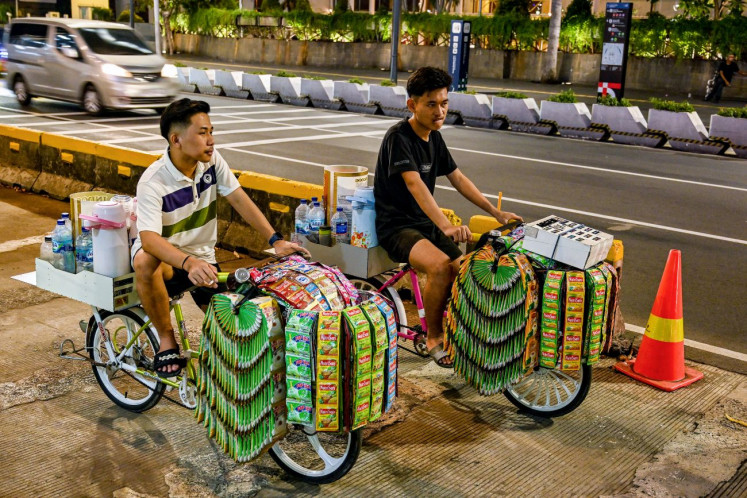Popular Reads
Top Results
Can't find what you're looking for?
View all search resultsPopular Reads
Top Results
Can't find what you're looking for?
View all search resultsLeveraging jamu heritage using science and technology
Almost all Indonesians know what jamu (traditional herbal medicine) is and have consumed it at one point in their lives. In fact, it is reported that 75 percent of all Indonesians consume jamu on a regular basis, either to prevent or treat diseases.
Change text size
Gift Premium Articles
to Anyone
A
lmost all Indonesians know what jamu (traditional herbal medicine) is and have consumed it at one point in their lives. In fact, it is reported that 75 percent of all Indonesians consume jamu on a regular basis, either to prevent or treat diseases. It has been consumed for over a millennium, at least according to the oldest historic proof, reliefs carved on Borobudur Temple (although jamu might even pre-exist long before that). So jamu has been an integral part of Indonesia’s socio-cultural identity.
However, despite its popularity and a 10 percent annual growth of the jamu industry, there is fear that the Indonesian jamu heritage will eventually wane due to the prevalence of modern medication. In addition to the traditional image of jamu (which is often regarded not as effective as modern medication), conventional health services in Indonesia do not yet facilitate a platform for the growth of jamu. Prescriptions for medications only use modern medicines, despite regulations to push the usage of jamu in healthcare. There are also increasing cases in which jamu is mixed with chemical compounds. The practice that is illegal due to synergistic effects of jamu and the chemical compounds that can potentially be dangerous. These issues can negatively affect the perception of people who consume or are interested in consuming jamu, which might also affect jamu’s long-term survival.
Being an integral part of Indonesia’s socio-cultural identity, the preservation of jamu is of great importance. Jamu is unique for each locality. The purposes of its use, the time of when it’s used and the herbs used are a depiction of the unique culture, geography and biological diversity of its place of origin, and Indonesia as a whole. Jamu can teach us a lot about ourselves and is an important cultural heritage.
There have been many efforts for the preservation of jamu. The Indonesian government has even proposed to UNESCO to make jamu a world heritage. However, after more or less a decade since the proposal, jamu has yet to be accepted as a UNESCO world heritage. To make people realize the significance of jamu, it is important to leverage knowledge on its importance, which could massively improve jamu’s image and will most likely help jamu strive and be preserved. Unfortunately, the efforts to leverage perception on jamu are currently only focused on the aspect of hygiene and safety in its consumption. More efforts in leveraging jamu’s image need to be done, especially related to its original use, which is for medication and healing.
The government has implemented a program called the “scientification of jamu,” which tries to use scientific methods to convince doubters that jamu has strong scientific grounding. It started in the era of President SBY in 2010. The Government even established a national committee for the scientification of jamu in 2013. Unfortunately, a quick google scholar search using the keywords “scientification of jamu,” “jamu scientification” and “saintifikasi jamu” only resulted in 12, 24 and 317 hits respectively. The low amount of publications after almost a decade of its introduction is an early indication of a lack of enthusiasm toward the jamu scientification, at least in academia.
The guidelines made by the national committee for jamu scientification are actually quite robust. However, looking at the number of publications in scientific journals, especially those that are of international pedigree, implementation still needs to be reviewed. Perhaps a national research agenda involving researchers with relevant competencies toward jamu scientification can be one option.
The aspects of scientification of jamu range from understanding the clinical practice, context of usage, safety of usage, effectiveness, elucidation of active compounds related to therapeutic effect, and therapeutic mechanism. Ironically, one of the most comprehensive studies done on these aspects is actually done outside of Indonesia. Japan’s Nara Institute of Science and Technology (NAIST) has set up a jamu database that contains more than 5,000 jamu formulations along with some of the aspects that were mentioned. The database is a part of a larger herbal medicinal system database called KNApSack. Recent studies have attempted to use the KNApSack database to formulate new herbal medicinal systems. In the future, resources such as the KNApSack database will most likely be utilized to design next-generation personalized herbal medicinal systems.
NAIST’s KNApSack database is far from perfect though. It only contains raw data on the herbs that are used and the active compounds in them. It still lacks in context. There is still a knowledge gap that can be filled, such as the historical context of the jamu formulation, dominant active compounds that determine therapeutic effect of the jamu, their mechanisms, etc. This can be a starting point for a long-term research on jamu and should be explored by the Indonesian Government.
The demise of PT Nyonya Meneer in 2017, one of the oldest jamu makers in Indonesia, after operating for almost a century, can serve as a metaphor for the future of Indonesia’s jamu heritage. If this amazing heritage is mismanaged, it is not impossible to lose it. A stronger narrative on the preservation of Indonesia’s jamu heritage can be built using science and technology. Consequently, Indonesians will be more proud of their jamu heritage and put in more effort to study about it. Perhaps we could even gain better understanding about ourselves as a nation through knowledge of our jamu heritage.
***
The writer is a faculty member at the School of Government and Public Policy Indonesia, Sentul, Bogor











